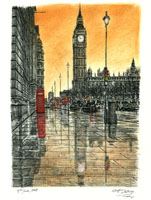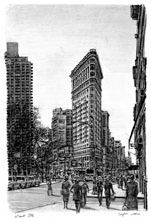"Earth as a Simulation Series 4: This Series offers MANY pages of Evidence that many Anomalous Experiences, Plus 'Exceptional' Abilities & Skills can be explained 'IF' we are Simulated copied people being Simulated with Less Advanced Technologies resulting in ourselves having Anomalous Experiences that relate to Hi-Tech Neural Implants & CNS Enhancements that the person we are simulating HAD, but which we are a long way from developing here!!!"
Main Page Headings List
- Accurate Architectural City Scape Reproductions Inclusive of Accurate 3D Perspective Example
- Hyper Realistic 3D Rendered Drawings Inclusive of Shadow & Lighting Effects
- What about 'Blind' people Painting in Exceptional Ways?
- Examples of Accurate Realistic Drawing 'Geniuses' in the Historical Past
- How Far Behind is our Technology Compared to the Original Population we are Simulating?
Accurate Architectural City Scape Reproductions Inclusive of Accurate 3D Perspective Example
 Stephen Wiltshire (called the human camera by some) seems likely to be simulating someone that has a very accurate 3D architectural drawing implant.
Stephen Wiltshire (called the human camera by some) seems likely to be simulating someone that has a very accurate 3D architectural drawing implant.
He has been filmed drawing a highly accurate and detailed sketch of various London landmarks that included over 200 buildings, with each drawn to scale and in the correct perspective. All done from memory after observing it all from a helicopter journey that lasted just 12 minutes!
 So, he’s considered to have a ‘camera like memory’ recording everything that he saw during a 12 minute helicopter journey over the city.
So, he’s considered to have a ‘camera like memory’ recording everything that he saw during a 12 minute helicopter journey over the city.
Later, he’s able to accurately recall and draw views of the city with the correct 3D perspective.
However, just a few seconds of thinking are needed to realise that a camera memory very likely isn’t enough. He’s drawing a panoramic view from views from a moving helicopter likely flying along parallel to the end panoramic view.
This implies that he has an internal 2D to 3D translation, referencing and viewpoint system (which would require images from different view viewpoints to reconstruct an accurate 3D view from one viewing place) that uses all of the journey views to construct an encompassing panoramic view accurate from one fixed ‘aerial’ point
You can get some idea of what I mean by looking at this page here which is of him in the middle of drawing a panoramic view of Singapore FROM MEMORY.
The video below is of his helicopter journey and then of him drawing the view afterwards.
Hyper Realistic 3D Rendered Drawings Inclusive of Shadow & Lighting Effects
Stefan Pabst draws what are described as hyper realistic 3D drawings. Basically, he very accurately draws an object/subject which from a very specific viewpoint appears to be ‘real’. Below is a speeded up video of him drawing a snake.
This is what I’d expect if someone had a 3D Graphics ‘Blender’ type implant that maybe even inputs and translates specific external objects into an accurate 3D image.
Once the image is captured and in 3D format you’d have filter options which would include shading and lighting. I’ve noticed that Stefan’s drawings seem to have very accurate shading and also they are drawn with very specific lighting effects that enhance the 3D appearance of the image. You would expect lighting effects to be integral to a professional grade 3D image renderer and particularly one that had artistic leanings.
What about ‘Blind’ people Painting in Exceptional Ways?
On the ‘Discovery Channel’ series named “The Super Humans”, in one episode a completely blind man (from birth) is presented that paints perspectives with amazing accuracy, almost as well as a sighted person (the video is here). What he does cannot be explained by science to such a degree that he has confounded the ‘expectations’ that science has on some aspects of ‘eyesight’ and how they ‘thought’ the brain works.
Examples of Accurate Realistic Drawing ‘Geniuses’ in the Historical Past
 Gottfried Mind was born in 1768. At the age of 8 Gottfried was placed in an art academy because despite having a very weak ‘constitution’ and being incapable of hard work, he had a talent for drawing.
Gottfried Mind was born in 1768. At the age of 8 Gottfried was placed in an art academy because despite having a very weak ‘constitution’ and being incapable of hard work, he had a talent for drawing.
He eventually focused on drawing extremely life like cat’s. The below is taken from wikipedia:
“Mind seldom drew from Nature; at most he did it with a few strokes. His conception was so strong, that whatever he had once strictly observed, stamped itself so firmly in his memory that, on his return home, and often a considerable time afterwards, he could represent it with entire fidelity. On such occasions he would look now and then, as it were, into himself; and when at these moments, he lifted his head, his eyes had something dreamy in them.”
How Far Behind is our Technology Compared to the Original Population we are Simulating?
So, the above perhaps early simulated human enhancement example was from 250 years ago . . .
In other words this gives you ‘some’ idea of how much our technologies here have been slowed down compared to the original population we are simulating.
PLEASE NOTE: For those of you that have ‘landed’ on this page then you should read the first and second ‘simulation’ series to gain context. There are very ‘rational’ reasons as to why you’d HAVE to slow the rate of technological development down if you are simulating copies of self aware people . . . this is all explained in very worrying ‘reasoned’ detail in the second series.
Click the right >> link below for the next page in this series . .
November 23, 2015 @ 9:36 pm
The 2D to 3D translation in these drawing examples is indeed impressive. I think people in various areas are able to do this to a lesser degree. An as example – I can think of a surgeon that can look at 2D images and plan his surgery. Yes – some of the new machines can make 3D images – but there are some amazing people that can correlate this on their own inside the body and have been doing this a long time. How about a landscaper that sees only the 2D photo of the front of a house and can design a complete 3D yard scape? Or a floral designer?
Also – tailors – many scratch out 2D drawings on pieces of paper, and then are able to direct people to sew the 3D outfit. Some make patterns but some don’t. Keep in mind a pattern is still only a 2D piece of paper. The 2D pattern pieces have to be perfect to turn into an accurate 3D outfit. I know some tailors spend hours fitting and fitting, and make straw-man dresses many times – but that is too expensive for the average person.
I personally was involved with something similar. I was asked as a favor, to make an evening gown for a friend of a friend (as a surprise). This is not normally something I would do , and is not my profession, but I could not say no. Knowing the person – I fully expected a conservative design that could be made from an off- the- shelf pattern. I then received a ripped out page from Vogue Magazine with an “over the top” very complicated 2D dress photo – with only half of the front and half of the back of the dress showing. I was sent some basic dimensions, no fabric, and a suggestion of a color that was like ivory, but lighter, more matte, like this, but that….. I never saw the person who was to receive the dress. Now I cannot draw a stick person much less sketches of an entire dress. I need to look at the 2D picture and in my head, I can take the image apart and form 3D patterns as well as the missing sections of the front and back. I also knew this design would not look this way on anyone other than a supermodel, and I had to make accommodations for a real person’s body. I still can’t draw the patterns – just have to start cutting and approximate the dimensions based on the size of my hand related to the dimensions received. I spent many nights waking up and seeing the dress pieces exploding inside my head, like a CAD system, swirling into 3D pieces and layers. Put it together and take it part in my head. Over and over. I then had to travel up inside the photo of the 2D outfit, translated inside my head into the full 3D dress, to see how it would “feel”, “poof”, “swirl”. and lay against the body ( is it scratchy”?) Is it going to fall down while dancing? Does it need to be tighter? How much is it going to weigh? And then the embellishments. It all came together and was given as a gift. The recipient asked how I matched the color so good. I don’t know – but based on the description above – a certain color pops in my head. It was perfect.
And I have seen other tailors do this.
One lady in Malaysia , decades ago, took one look at me and made a perfect outfit for me – come back in one week – with no measurements! ( you never hear about these people).
November 24, 2015 @ 1:57 pm
Hi Annabelle, yea very good ‘enhancement’ example, ‘tailoring’ is an obvious profession where an external 3D object to 2D mapping ‘sewing’ pattern enhancement would be very useful.